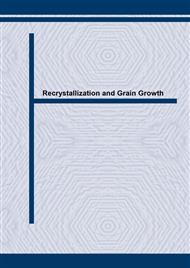p.287
p.293
p.299
p.305
p.311
p.317
p.323
p.329
p.335
Rolling and Recrystallization Texture of Cold Rolled IF Steel: A Study from Low to High Deformation
Abstract:
IF steel was homogeneously cold rolled between 30-95% reduction in thickness. The global cold rolling textures showed a gradual strengthening of both stable α and γ components with increasing reduction until ~80% after which γ remained effectively unchanged but α components intensified until 95% reduction of thickness. Deformation Banded (DB) and also fragmented microstructures were found exclusively in γ grains up until about 85% reduction after which DB was unexpectedly detected in α grains, becoming significant after 95% reduction. This is in sharp contrast with the rather undifferentiated microstructures found in α grains at low to medium levels of deformation. At lower reductions the annealing texture was a weak α, but the γ component increased with rolling strain and became dominant at ~80% rolling deformation. A peak type γ recrystallisation texture with orientations ranging from {554}<225> to {111}<123> was found in the 95% rolled sample. In addition to this a {411}<148> component began to intensify, reading 5R at 95% reduction. Microstructural analysis showed that DB provided the lattice curvature for nucleation in the α fibre.
Info:
Periodical:
Pages:
311-316
Citation:
Online since:
October 2004
Authors:
Keywords:
Price:
Сopyright:
© 2004 Trans Tech Publications Ltd. All Rights Reserved
Share:
Citation:


